
Econometrica,Vol.53,No.6 (November,1985) CONTINUOUS AUCTIONS AND INSIDER TRADING BY ALBERT S.KYLE A dynamic model of insider trading with sequential auctions,structured to resemble a sequential equilibrium,is used to examine the informational content of prices,the liquidity characteristics of a speculative market,and the value of private information to an insider. The model has three kinds of traders:a single risk neutral insider,random noise traders, and competitive risk neutral market makers.The insider makes positive profits by exploiting his monopoly power optimally in a dynamic context,where noise trading provides camou- flage which conceals his trading from market makers.As the time interval between auctions goes to zero,a limiting model of continuous trading is obtained.In this equilibrium,prices follow Brownian motion,the depth of the market is constant over time,and all private information is incorporated into prices by the end of trading. 1.INTRODUCTION How QUICKLY IS NEW PRIVATE INFORMATION about the underlying value of a speculative commodity incorporated into market prices?How valuable is private information to an insider?How does noise trading affect the volatility of prices? What determines the liquidity of a speculative market?The purpose of this paper is to show how answers to questions like these can be obtained as derived results by modelling rigorously the trading strategy of an insider in a dynamic model of efficient price formation. In the particular model we investigate,one risky asset is exchanged for a riskless asset among three kinds of traders:a single insider who has unique access to a private observation of the ex post liquidation value of the risky asset; uninformed noise traders who trade randomly;and market makers who set prices efficiently (in the semi-strong sense)conditional on information they have about the quantities traded by others.Trading is modelled as a sequence of many auctions,structured to give the model the flavor of a sequential equilibrium as described by Kreps and Wilson [4]. At each auction trading takes place in two steps.In step one,the insider and the noise traders simultaneously choose the quantities they will trade(in effect, placing "market orders").When making this choice,the insider's information consists of his private observation of the liquidation value of the asset,as well as past prices and past quantities traded by himself.He does not observe current or future prices,or current or future quantities traded by noise traders.The random quantity traded by noise traders is distributed independently from present or past quantities traded by the insider and independently from past quantities traded by noise traders.In step two,the market makers set a price,and trade the quantity which makes markets clear.When doing so,their information consists of observations of the current and past aggregate quantities traded by the insider and noise traders combined.We call these aggregate quantities the"order flow." The author thanks the Centre of Policy Studies,Monash University,and the Yale School of Organization and Management,Yale University,for their hospitality and support when this research was undertaken.The author also thanks Paul Milgrom,Peter Hartley,Phil Dybvig,and Avinash Dixit for useful comments. 1315
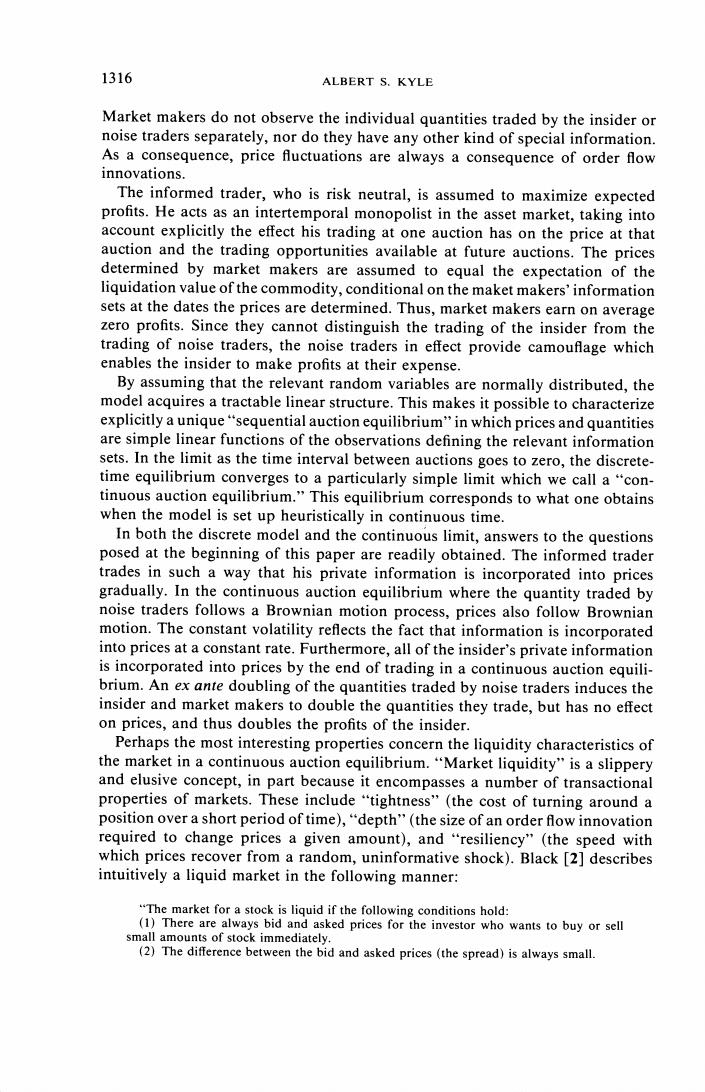
1316 ALBERT S.KYLE Market makers do not observe the individual quantities traded by the insider or noise traders separately,nor do they have any other kind of special information. As a consequence,price fluctuations are always a consequence of order flow innovations. The informed trader,who is risk neutral,is assumed to maximize expected profits.He acts as an intertemporal monopolist in the asset market,taking into account explicitly the effect his trading at one auction has on the price at that auction and the trading opportunities available at future auctions.The prices determined by market makers are assumed to equal the expectation of the liquidation value of the commodity,conditional on the maket makers'information sets at the dates the prices are determined.Thus,market makers earn on average zero profits.Since they cannot distinguish the trading of the insider from the trading of noise traders,the noise traders in effect provide camouflage which enables the insider to make profits at their expense. By assuming that the relevant random variables are normally distributed,the model acquires a tractable linear structure.This makes it possible to characterize explicitly a unique"sequential auction equilibrium"in which prices and quantities are simple linear functions of the observations defining the relevant information sets.In the limit as the time interval between auctions goes to zero,the discrete- time equilibrium converges to a particularly simple limit which we call a"con- tinuous auction equilibrium."This equilibrium corresponds to what one obtains when the model is set up heuristically in continuous time. In both the discrete model and the continuous limit,answers to the questions posed at the beginning of this paper are readily obtained.The informed trader trades in such a way that his private information is incorporated into prices gradually.In the continuous auction equilibrium where the quantity traded by noise traders follows a Brownian motion process,prices also follow Brownian motion.The constant volatility reflects the fact that information is incorporated into prices at a constant rate.Furthermore,all of the insider's private information is incorporated into prices by the end of trading in a continuous auction equili- brium.An ex ante doubling of the quantities traded by noise traders induces the insider and market makers to double the quantities they trade,but has no effect on prices,and thus doubles the profits of the insider. Perhaps the most interesting properties concern the liquidity characteristics of the market in a continuous auction equilibrium."Market liquidity"is a slippery and elusive concept,in part because it encompasses a number of transactional properties of markets.These include "tightness"(the cost of turning around a position over a short period of time),"depth"(the size of an order flow innovation required to change prices a given amount),and "resiliency"(the speed with which prices recover from a random,uninformative shock).Black [2]describes intuitively a liquid market in the following manner: "The market for a stock is liquid if the following conditions hold: (1)There are always bid and asked prices for the investor who wants to buy or sell small amounts of stock immediately. (2)The difference between the bid and asked prices (the spread)is always small

CONTINUOUS AUCTIONS 1317 (3)An investor who is buying or selling a large amount of stock,in the absence of special information,can expect to do so over a long period of time at a price not very different,on average,from the current market price. (4)An investor can buy or sell a large block of stock immediately,but at a premium or discount that depends on the size of the block.The larger the block,the larger the premium or discount. In other words,a liquid market is a continuous market,in the sense that almost any amount of stock can be bought or sold immediately,and an efficient market,in the sense that small amounts of stock can always be bought and sold very near the current market price,and in the sense that large amounts can be bought or sold over long periods of time at prices that,on average,are very near the current market price." Roughly speaking,Black defines a liquid market as one which is almost infinitely tight,which is not infinitely deep,and which is resilient enough so that prices eventually tend to their underlying value. Our continuous auction equilibrium has exactly the characteristics described by Black.Furthermore,these aspects of market liquidity acquire a new prominence in our model because the insider,who does not trade as a perfect competitor, must make rational conjectures about tightness,depth,and resiliency in choosing his optimal quantity to trade.Moreover,depth and resiliency are themselves endogenous consequences of the presence of the insider and noise traders in the market.Market depth is proportional to the amount of noise trading and inversely proportional to the amount of private information (in the sense of an error variance)which has not yet been incorporated into prices.This makes our model a rigorous version of the intuitive story told by Bagehot [1].Furthermore,our emphasis on the dynamic optimizing behavior of the insider distinguishes our model from the one of Glosten and Milgrom [3]. The plan of the rest of this paper is as follows:In Section 2,a single auction equilibrium is discussed in order to motivate the dynamic models which follow. In Section 3,a sequential auction equilibrium is defined,an existence and uniqueness result is proved,and properties of the equilibrium are derived.In Section 4,a continuous auction equilibrium is discussed heuristically,and in Section 5,it is shown that the continuous auction equilibrium is the limit of the sequential auction equilibrium as the time interval between auctions goes to zero. Section 6 makes some concluding comments. 2.A SINGLE AUCTION EQUILIBRIUM In this section we motivate our equilibrium concept by discussing a simple model of one-shot trading. Structure and Notation.The ex post liquidation value of the risky asset,denoted is normally distributed with mean po and variance So.The quantity traded by noise traders,denoted u,is normally distributed with mean zero and variance o.The random variables o and u are independently distributed.The quantity traded by the insider is denoted x and the price is denoted p. Trading is structured in two steps as follows:In step one,the exogenous values of and are realized and the insider chooses the quantity he trades x When
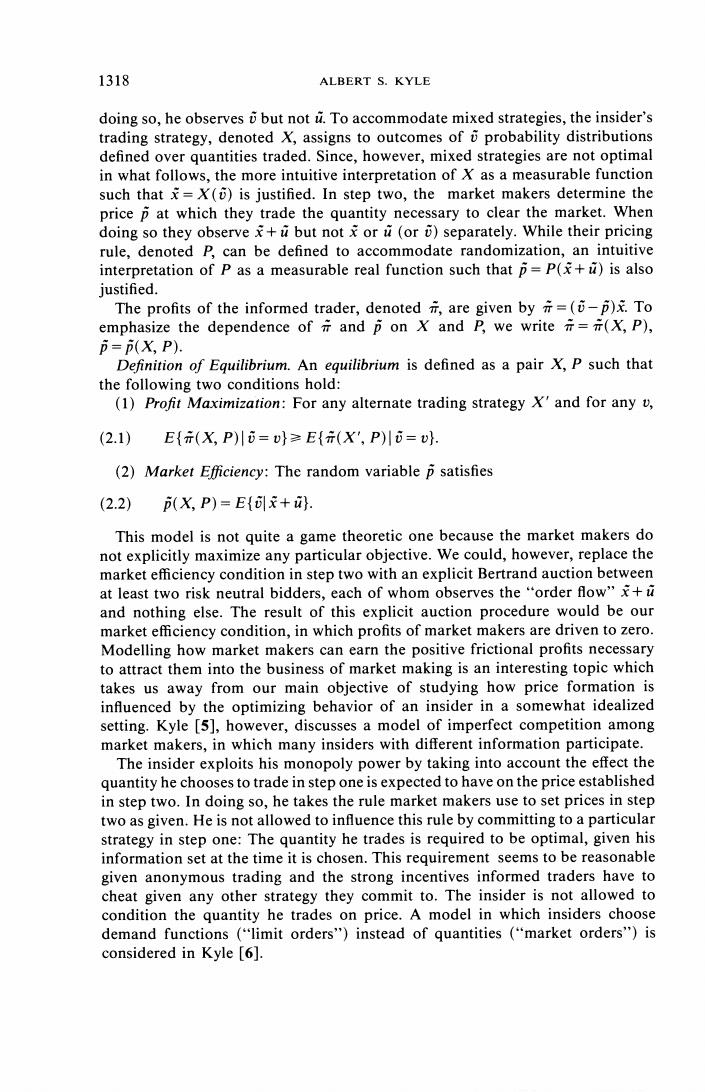
1318 ALBERT S.KYLE doing so,he observes o but not u.To accommodate mixed strategies,the insider's trading strategy,denoted X,assigns to outcomes of probability distributions defined over quantities traded.Since,however,mixed strategies are not optimal in what follows,the more intuitive interpretation of X as a measurable function such that=X()is justified.In step two,the market makers determine the price p at which they trade the quantity necessary to clear the market.When doing so they observe+but not or (or separately.While their pricing rule,denoted P,can be defined to accommodate randomization,an intuitive interpretation of P as a measurable real function such that p=P(+)is also justified. The profits of the informed trader,,denoted元,are given by亓=(i-p)x.To emphasize the dependence of and p on X and p,we write=(X,P), =(X,P). Definition of Equilibrium.An equilibrium is defined as a pair X,P such that the following two conditions hold: (1)Profit Maximization:For any alternate trading strategy X'and for any v, (2.1) E{亓(X,P)川i=}≥E{(X',P)川i=v} (2)Market Efficiency:The random variable p satisfies (2.2) (X,P)=E{创x+. This model is not quite a game theoretic one because the market makers do not explicitly maximize any particular objective.We could,however,replace the market efficiency condition in step two with an explicit Bertrand auction between at least two risk neutral bidders,each of whom observes the "order flow"+ and nothing else.The result of this explicit auction procedure would be our market efficiency condition,in which profits of market makers are driven to zero. Modelling how market makers can earn the positive frictional profits necessary to attract them into the business of market making is an interesting topic which takes us away from our main objective of studying how price formation is influenced by the optimizing behavior of an insider in a somewhat idealized setting.Kyle [5],however,discusses a model of imperfect competition among market makers,in which many insiders with different information participate. The insider exploits his monopoly power by taking into account the effect the quantity he chooses to trade in step one is expected to have on the price established in step two.In doing so,he takes the rule market makers use to set prices in step two as given.He is not allowed to influence this rule by committing to a particular strategy in step one:The quantity he trades is required to be optimal,given his information set at the time it is chosen.This requirement seems to be reasonable given anonymous trading and the strong incentives informed traders have to cheat given any other strategy they commit to.The insider is not allowed to condition the quantity he trades on price.A model in which insiders choose demand functions ("limit orders")instead of quantities ("market orders")is considered in Kyle [6]

CONTINUOUS AUCTIONS 1319 Fortuitously,our model has an analytically tractable equilibrium in which the rules X and P are simple linear functions,as we show in the following theorem: THEOREM 1:There exists a unique equilibrium in which X and P are linear functions.Defining constants B and A by B=()2 and =2(/)12,the equilibrium P and X are given by (2.3)X()=B(i-Po,P(x+)=po+A(元+i) Proof:Suppose that for constants u,A,a,B,linear functions P and X are given by (2.4) P(y)=u+ay,X(v)=a+Bv. Given the linear rule P,profits can be written (2.5)E{[i-P(x+)]xi=}=(u-4-Ax)x Profit maximization of this quadratic objective requires that x solve v-u-2Ax= 0.We thus have X(v)=a+Bu with (2.6)1/B=2入,a=-uB. Note that the quadratic objective(implied by the linear pricing rule P)rules out mixed strategies and also makes linear strategies optimal even when nonlinear strategies are allowed. Given linear X and P,the market efficiency condition is equivalent to (2.7) u+入y=E{创a+Bi+i=y}. Normality makes the regression linear and application of the projection theorem yields BΣo (2.8) 入= B2o+-Po=-A(a+Bpo). Solving (2.6)and(2.8)subject to the second order condition A>0 yields the desired result.Note that we have u=po,a=-Bpo,and the second order condition rules out a solution with B and A both negative.This completes the proof of the theorem. Properties of the Equilibrium.The equilibrium X and P are determined by the exogenous parameters Eo and o.To obtain a measure of the informativeness of prices,.defineΣ,byΣ,=var{lp}.A simple calculation shows that∑,=∑o; thus,one-half of the insider's private information is incorporated into prices and the volatility of prices is unaffected by the level of noise trading ou. The quantity 1/A measures the "depth"of the market,i.e.the order flow necessary to induce prices to rise or fall by one dollar.This measure of market liquidity is proportional to a ratio of the amount of noise trading to the amount of private information the informed trader is expected to have.In this sense,it
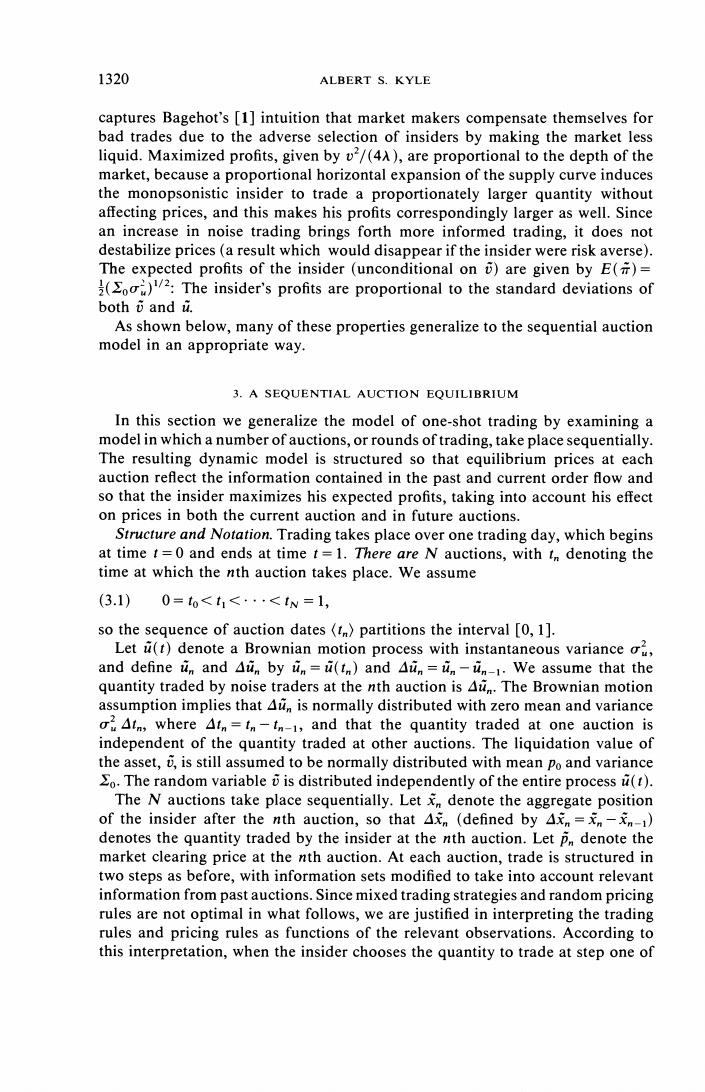
1320 ALBERT S.KYLE captures Bagehot's [1]intuition that market makers compensate themselves for bad trades due to the adverse selection of insiders by making the market less liquid.Maximized profits,given by v/(4A),are proportional to the depth of the market,because a proportional horizontal expansion of the supply curve induces the monopsonistic insider to trade a proportionately larger quantity without affecting prices,and this makes his profits correspondingly larger as well.Since an increase in noise trading brings forth more informed trading,it does not destabilize prices(a result which would disappear if the insider were risk averse). The expected profits of the insider (unconditional on are given by E()= )/2:The insider's profits are proportional to the standard deviations of both o and u. As shown below,many of these properties generalize to the sequential auction model in an appropriate way. 3.A SEQUENTIAL AUCTION EQUILIBRIUM In this section we generalize the model of one-shot trading by examining a model in which a number of auctions,or rounds of trading,take place sequentially. The resulting dynamic model is structured so that equilibrium prices at each auction reflect the information contained in the past and current order flow and so that the insider maximizes his expected profits,taking into account his effect on prices in both the current auction and in future auctions. Structure and Notation.Trading takes place over one trading day,which begins at time t=0 and ends at time t=1.There are N auctions,with tn denoting the time at which the nth auction takes place.We assume (3.1) 0=to<t<·<tw=1, so the sequence of auction dates(t)partitions the interval [0,1]. Let a(t)denote a Brownian motion process with instantaneous variance and define tin and Atn by tn=(t)and Ain=n1.We assume that the quantity traded by noise traders at the nth auction is A.The Brownian motion assumption implies that Adn is normally distributed with zero mean and variance oAt,where At=tn-t-1,and that the quantity traded at one auction is independent of the quantity traded at other auctions.The liquidation value of the asset,is still assumed to be normally distributed with mean po and variance So.The random variable o is distributed independently of the entire process u(t). The N auctions take place sequentially.Let denote the aggregate position of the insider after the nth auction,so that A (defined by = denotes the quantity traded by the insider at the nth auction.Let pr denote the market clearing price at the nth auction.At each auction,trade is structured in two steps as before,with information sets modified to take into account relevant information from past auctions.Since mixed trading strategies and random pricing rules are not optimal in what follows,we are justified in interpreting the trading rules and pricing rules as functions of the relevant observations.According to this interpretation,when the insider chooses the quantity to trade at step one of
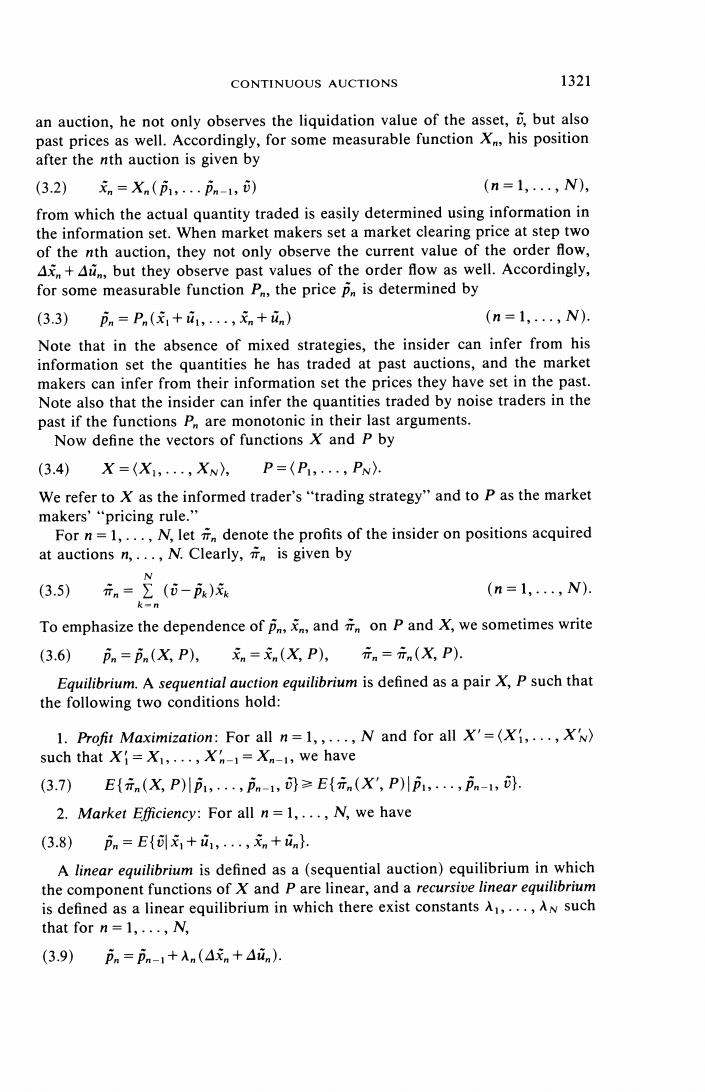
CONTINUOUS AUCTIONS 1321 an auction,he not only observes the liquidation value of the asset,but also past prices as well.Accordingly,for some measurable function X,his position after the nth auction is given by (3.2)n=Xn(户1,…户n-1,) (n=1,.,N), from which the actual quantity traded is easily determined using information in the information set.When market makers set a market clearing price at step two of the nth auction,they not only observe the current value of the order flow, A+At,but they observe past values of the order flow as well.Accordingly, for some measurable function P,the price p is determined by (3.3)pn=Pn(元1+i1,,元n+an) (n=1,.,N). Note that in the absence of mixed strategies,the insider can infer from his information set the quantities he has traded at past auctions,and the market makers can infer from their information set the prices they have set in the past. Note also that the insider can infer the quantities traded by noise traders in the past if the functions P are monotonic in their last arguments. Now define the vectors of functions X and P by (3.4)X=(X1,,XN),P=(P,,PN) We refer to X as the informed trader's"trading strategy"and to P as the market makers'"pricing rule." For n=1,...,N,let denote the profits of the insider on positions acquired at auctions n,...,N.Clearly,is given by N (3.5) 元n=∑(i-p) (n=1,..,N) To emphasize the dependence of p,,and on P and X,we sometimes write (3.6) pn=pn(X,P),xn=元n(X,P),方n=元n(X,P): Equilibrium.A sequential auction equilibrium is defined as a pair X,P such that the following two conditions hold: 1.Profit Maximization:For all n =1,,...,N and for all X'=(X,...,XN) such thatX=X1,...,X1=Xn-1,we have (3.7) E{元n(XP川i1,,户n-1,≥E{元n(X',P)川i,…,in-l,. 2.Market Efficiency:For all n=1,...,N,we have (3.8)pn=E{x1+a1,,n+in} A linear equilibrium is defined as a(sequential auction)equilibrium in which the component functions of X and P are linear,and a recursive linear equilibrium is defined as a linear equilibrium in which there exist constants A1,...,AN such that for n=1,...,N, (3.9)币n=pn-1+入n(△元n+4in)
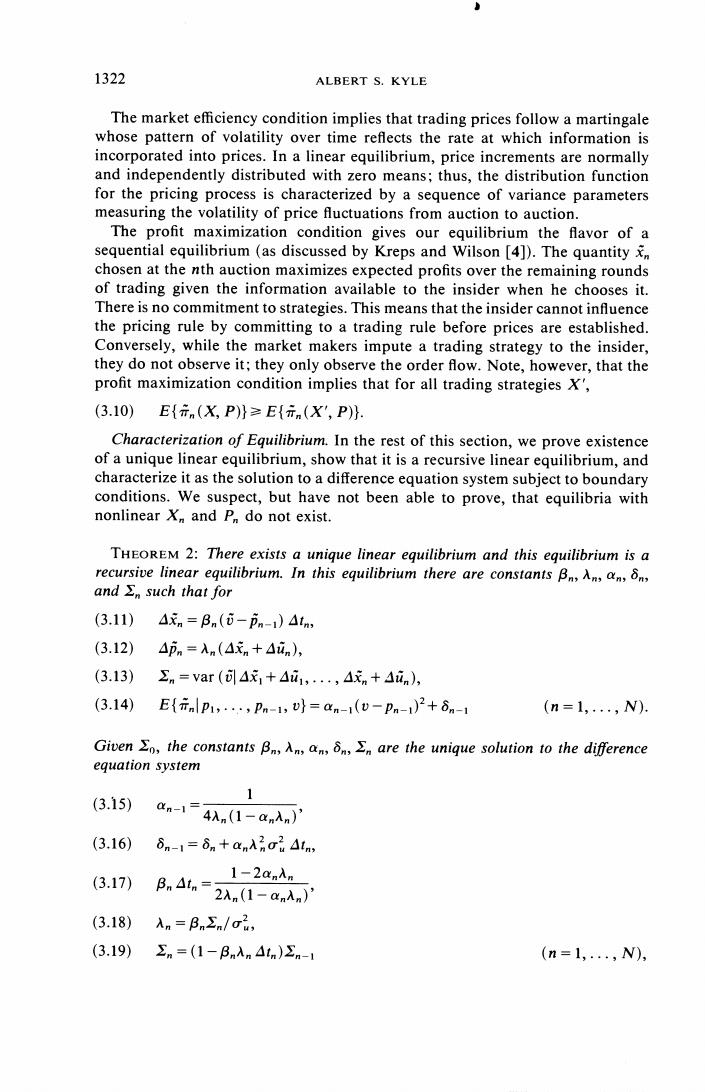
1322 ALBERT S.KYLE The market efficiency condition implies that trading prices follow a martingale whose pattern of volatility over time reflects the rate at which information is incorporated into prices.In a linear equilibrium,price increments are normally and independently distributed with zero means;thus,the distribution function for the pricing process is characterized by a sequence of variance parameters measuring the volatility of price fluctuations from auction to auction. The profit maximization condition gives our equilibrium the flavor of a sequential equilibrium(as discussed by Kreps and Wilson [4]).The quantity chosen at the nth auction maximizes expected profits over the remaining rounds of trading given the information available to the insider when he chooses it. There is no commitment to strategies.This means that the insider cannot influence the pricing rule by committing to a trading rule before prices are established. Conversely,while the market makers impute a trading strategy to the insider, they do not observe it;they only observe the order flow.Note,however,that the profit maximization condition implies that for all trading strategies X', (3.10)E{n(X,P)}≥E{元n(X',P) Characterization of Equilibrium.In the rest of this section,we prove existence of a unique linear equilibrium,show that it is a recursive linear equilibrium,and characterize it as the solution to a difference equation system subject to boundary conditions.We suspect,but have not been able to prove,that equilibria with nonlinear X and P do not exist. THEOREM 2:There exists a unique linear equilibrium and this equilibrium is a recursive linear equilibrium.In this equilibrium there are constants B,An,an,8n, andΣsuch that for (3.11) △xn=Bn(i-pn-1)4tn, (3.12) 4pn=入n(4元n+△in), (3.13) En=var(△x1+△i1,,△n+Ain), (3.14) E(inlpi;....Pn-1,0}=an-1(v-Pn-1)2+8n-1 (n=1.,N). Given o,the constants B,An,an,6,E are the unique solution to the difference equation system 1 (3.15) an-1=4n(1-an入n' (3.16) 6n-1=6n+an7c41n, (3.17) 1-2an入m Bn△1n-2Xn1-an (3.18) An=BnΣn/o2, (3.19) Σn=(1-Bn入m4tn)Σn-1 (n=1,.,N)
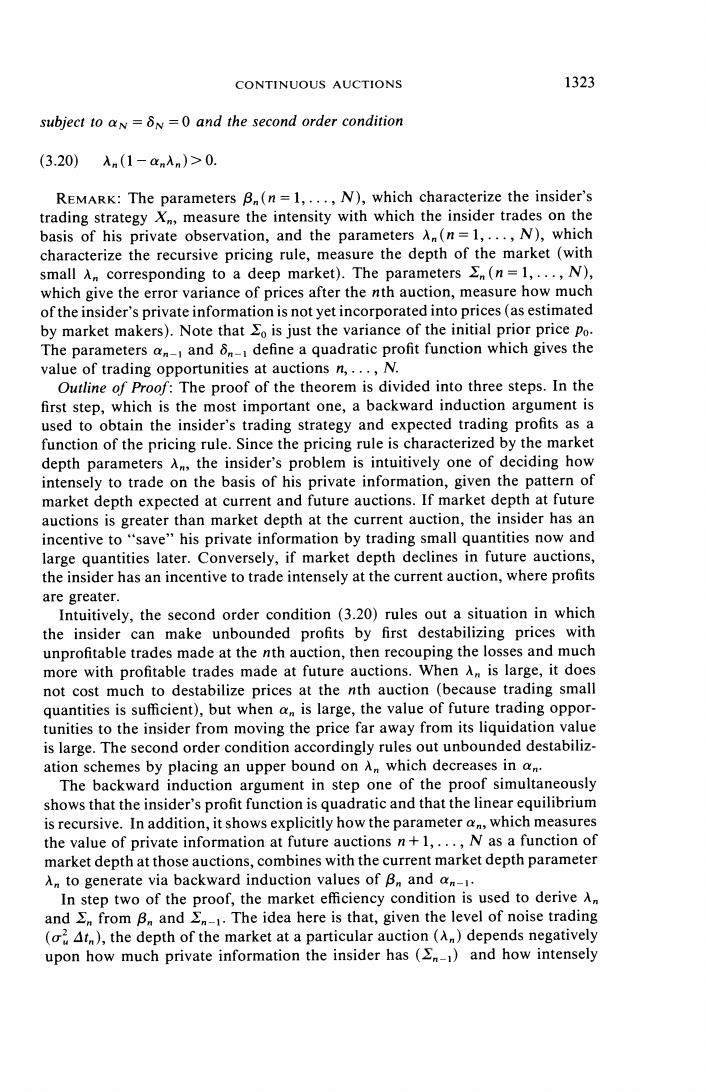
CONTINUOUS AUCTIONS 1323 subject to aN=8N=0 and the second order condition (3.20)入n(1-an入n)>0 REMARK:The parameters B(n=1,...,N),which characterize the insider's trading strategy X,measure the intensity with which the insider trades on the basis of his private observation,and the parametersA(n=1,...,N),which characterize the recursive pricing rule,measure the depth of the market(with small An corresponding to a deep market).The parameters (n=1,...,N), which give the error variance of prices after the nth auction,measure how much of the insider's private information is not yet incorporated into prices(as estimated by market makers).Note that So is just the variance of the initial prior price po. The parameters an-and 8-1 define a quadratic profit function which gives the value of trading opportunities at auctions n,...,N. Outline of Proof:The proof of the theorem is divided into three steps.In the first step,which is the most important one,a backward induction argument is used to obtain the insider's trading strategy and expected trading profits as a function of the pricing rule.Since the pricing rule is characterized by the market depth parameters An,the insider's problem is intuitively one of deciding how intensely to trade on the basis of his private information,given the pattern of market depth expected at current and future auctions.If market depth at future auctions is greater than market depth at the current auction,the insider has an incentive to"save"his private information by trading small quantities now and large quantities later.Conversely,if market depth declines in future auctions, the insider has an incentive to trade intensely at the current auction,where profits are greater. Intuitively,the second order condition(3.20)rules out a situation in which the insider can make unbounded profits by first destabilizing prices with unprofitable trades made at the nth auction,then recouping the losses and much more with profitable trades made at future auctions.When Am is large,it does not cost much to destabilize prices at the nth auction (because trading small quantities is sufficient),but when an is large,the value of future trading oppor- tunities to the insider from moving the price far away from its liquidation value is large.The second order condition accordingly rules out unbounded destabiliz- ation schemes by placing an upper bound on A which decreases in an The backward induction argument in step one of the proof simultaneously shows that the insider's profit function is quadratic and that the linear equilibrium is recursive.In addition,it shows explicitly how the parameter an,which measures the value of private information at future auctions n+1,...,N as a function of market depth at those auctions,combines with the current market depth parameter An to generate via backward induction values of B and an-1. In step two of the proof,the market efficiency condition is used to derive A, and S from B and n-1.The idea here is that,given the level of noise trading (oAt),the depth of the market at a particular auction (An)depends negatively upon how much private information the insider has (n1)and how intensely

1324 ALBERT S.KYLE the insider trades upon the basis of his private information (B),and this also determines how much of the insider's remaining private information is revealed at the particular auction and how much still remains private ()This step of the proof makes precise Bagehot's idea that market makers respond to insider trading by reducing the liquidity of the market. In step three of the proof,it is shown that the relationships derived in the first two steps generate a difference equation system which characterizes the unique linear equilibrium. PROoF:We now give the details of the three steps of the proof. Step 1.To prove by backward induction that the informed trader's expected profits are of the quadratic form specified in(3.14),we begin with the boundary condition aN=8N=0,which states that no profits on new positions are made after trade is completed.Now make the inductive hypothesis that for constants an andδn,we have (3.21)E{元n+(X,P)川p1,,Pn,}=an(D-Pn)2+δn Since元is given recursively by亓n=(i-pn)△xn+in+l,we obtain (3.22)E{元nlp1,..,pn-1,v}=maxE{(i-pn)△x Ax +an(-pn)2+8nlp1,...,Pn-1,vh. In a linear equilibrium,p is given by (3.23)Pn =Pn-1+An (Axn+Aun)+h, where h is some linear function of 4x1+4u,...,4x-1+Aun-1.Plugging (3.23) into(3.22)and evaluating the conditional expectation yields (3.24)E{元nlp1,,Pn-,b}=max{(v-Pn-1-入n△x-h)4x +an(D-pn-1-入n△x-h)2+anAng2△tn+6n}. Since maximized profits are quadratic in 4x,the maximizing Ax(which we write Ax)is easily shown to be given by (3.25)△xn=Bn(v-Pn-1-h)△tn, where B At is given by (3.17).The second order condition is (3.20). We now claim that h=0.To prove this,observe that the market efficiency condition implies (3.26)E{4pn|△元1+4i1,,4元-1+4in-}=0. An explicit calculation shows,however,that h (3.27)E{45.4,+4i,4-1+4i-i}-21-aA